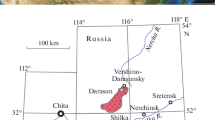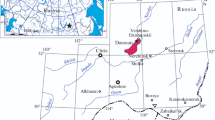Abstract
The rhythmically banded aggregates of Fe–tennantite with oscillatory zoning resulting from simultaneous variations in the concentrations of Sb and As and Zn and Fe were registered in the Darasun gold deposit (Eastern Transbaikalia). These aggregates were formed upon pseudomorphic replacement of early Zn–tetrahedrite. This process was initiated by the dissolution of Zn–tetrahedrite with the formation of an aggregate of galena, bournonite, and late tetrahedrite–tennantite. It is shown that rhythmically banded aggregates with an oscillatory zoning were formed as a result of coupled dissolution–reprecipitation reactions under the conditions that are far from the mineral–fluid chemical equilibrium and variations in the fluid composition controlled by kinetic factors.



Similar content being viewed by others
REFERENCES
B. W. D. Yardley, C. A. Rochelle, A. C. Barnicoat, et al., Mineral. Mag. 55, 357–365 (1991).
P. Ortoleva, J. Chadam, E. Merino, et al., Am. J. Sci. 287 (10), 1008–1040 (1987).
A. Putnis, M. Prieto, and H. Stoll, EMU Notes Mineral. 10, 43–64 (2010).
D. A. Timofeevskii, in Scientific Works of Central Scientific Research Geological Prospecting Institute of Nonferrous and Noble Metals (Nedra, Moscow, 1972), Issue 98 [in Russian].
N. G. Lyubimtseva, N. S. Bortnikov, S. E. Borisovsky, et al., Geol. Ore Deposits 60 (2), 93–120 (2018).
C. V. Putnis and L. Fernández-Díaz, EMU Notes Mineral. 10, 189–226 (2010).
J. Brugger, W. Liu, B. Etschmann, et al., Chem. Geol. 447, 219–235 (2016).
M. H. Reed and J. Palandri, Rev. Mineral. Geochem. 61, 609–631 (2006).
H. D. Holland, M. Borcsik, J. Munoz, et al., Geochim. Cosmochim. Acta 27 (9), 957–977 (1963).
F. Lippmann, Neues Jahrb. Mineral., Abh. 139 (1), 1–25 (1980).
M. Pietro, Rev. Mineral. Geochem. 70, 47–85 (2009).
ACKNOWLEDGMENTS
This study was supported by Ministry of Science and High School, project no. 0136-2018-0025. The EMPA studies were supported by the Russian Science Foundation, project no. 14-17-00693-P.
Author information
Authors and Affiliations
Corresponding author
Additional information
Translated by A. Bobrov
Rights and permissions
About this article
Cite this article
Lyubimtseva, N.G., Bortnikov, N.S., Borisovsky, S.E. et al. Pseudomorphic Rhythmically Banded and Oscillatory Tetrahedrite–Tennantite Aggregates in the Darasun Gold Deposit (Eastern Transbaikalia, Russia): A Result of Coupled Dissolution–Reprecipitation Reactions. Dokl. Earth Sc. 483, 1431–1436 (2018). https://doi.org/10.1134/S1028334X18110041
Received:
Published:
Issue Date:
DOI: https://doi.org/10.1134/S1028334X18110041




